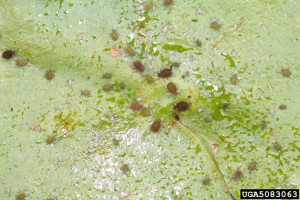
waterlily aphid colony on pond-lily pad. Photo by Whitney Cranshaw, Colorado State University, Bugwood.org.
One of the things I love about my job is that there’s always something new to learn. And one of the things I appreciate about the Insects in the City News Updates is that it gives me someone to share the things I learn with.
My discovery this week is aquatic aphids. Most long-time gardeners know that aphids are pretty adaptable. Tiny sap-feeders, sometimes erroneously called plant lice, aphids are one of the most common pests of flowers, trees and vegetable gardens. Normally found on stems and leaves, some aphids even go underground to feed on plant roots. Last week I had a question from a local botanical garden about aphids feeding in ponds, on water lilies.
It turns out that at least one species of aphid likes to hang out at the pond–a lot. Rhopalosiphum nymphae, also known as the waterlily aphid, alternates between cool season hosts (trees, like peaches, apricot and almonds in the genus Prunus) and waterlilies, cattails, buttercup and knotweed in late summer. According to colleagues I contacted, these aphids are most likely to be pests in later summer and early fall, when they can cause leaves to brown and dessicate–although often their damage coincides with the time when plants are beginning to die for the winter. Based on collective wisdom of my entomology friends, the best solution is to “swish the leaves” in the water or physically wash them off with a stiff stream of water. Presumably this works best in ponds with fish or other aquatic predators who ensure that a floating aphid’s life is short.
In late fall, winged adult waterlily aphids leave their aquatic homes to more protected sites on fruit trees. There the females lay eggs, the only stage to survive the winter, in cracks in the bark of the trees. Come spring the aphids, known now as “reddish-brown plum aphids,” go through multiple generations feeding on sap from the trees. Then in mid- to late summer, it’s back to the pond.
According to the comprehensive USDA Technical Bulletin 1870 on arthropod pests of aquatic plants, waterlily aphids readily walk on the surface of the pond and can crawl down emergent plant parts to feed underwater. Specialized “hairs” on their bodies trap and hold air while underwater, allowing them to make this remarkable habitat shift. Reproduction can be rapid, literally blanketing plants. The bulletin notes that at least in some cases the waterlily aphid can be extremely destructive in aquatic gardens and nurseries and is known to transmit at least five plant viruses.
Contrary to what you might find on the Internet, it’s not a good idea to use malathion or other common aphicides on aquatic plants. Not many insecticides are labeled for use on aquatic plants for the simple reason most insecticides are highly toxicity to fish and other aquatic invertebrates. Soaps or oils might be used safely by removing the plants temporarily from the water, spraying and rinsing them, and returning them back quickly. But this seems as much or more work than “swishing”. If Prunus trees are growing near your pond, there might be some value to treating the trees (as long as they are not to close to the water) with a soil-applied systemic insecticide like imidacloprid. To my knowledge, however, this approach is yet to be validated by research.
So thanks for letting me share my recently acquired knowledge about aquatic aphids. Now if it doesn’t cool down soon, I think I might just join these little guys in the water.